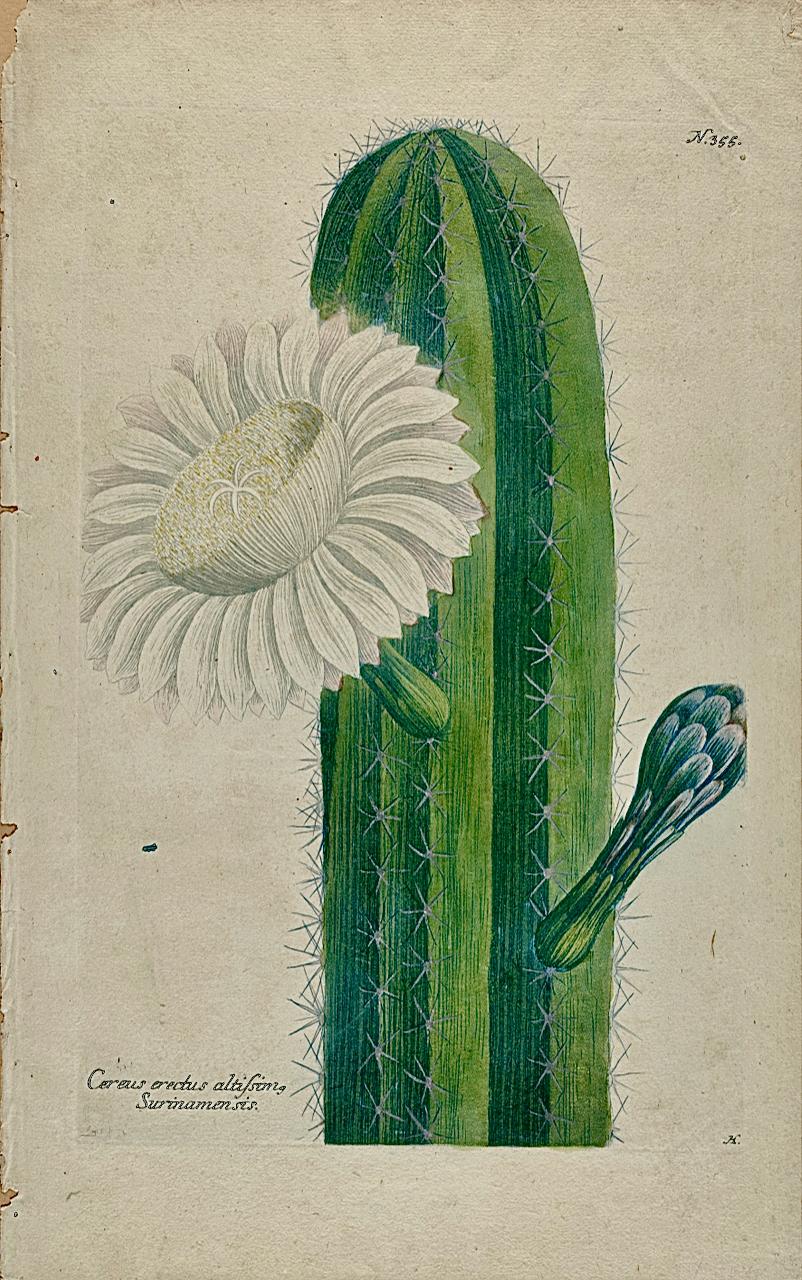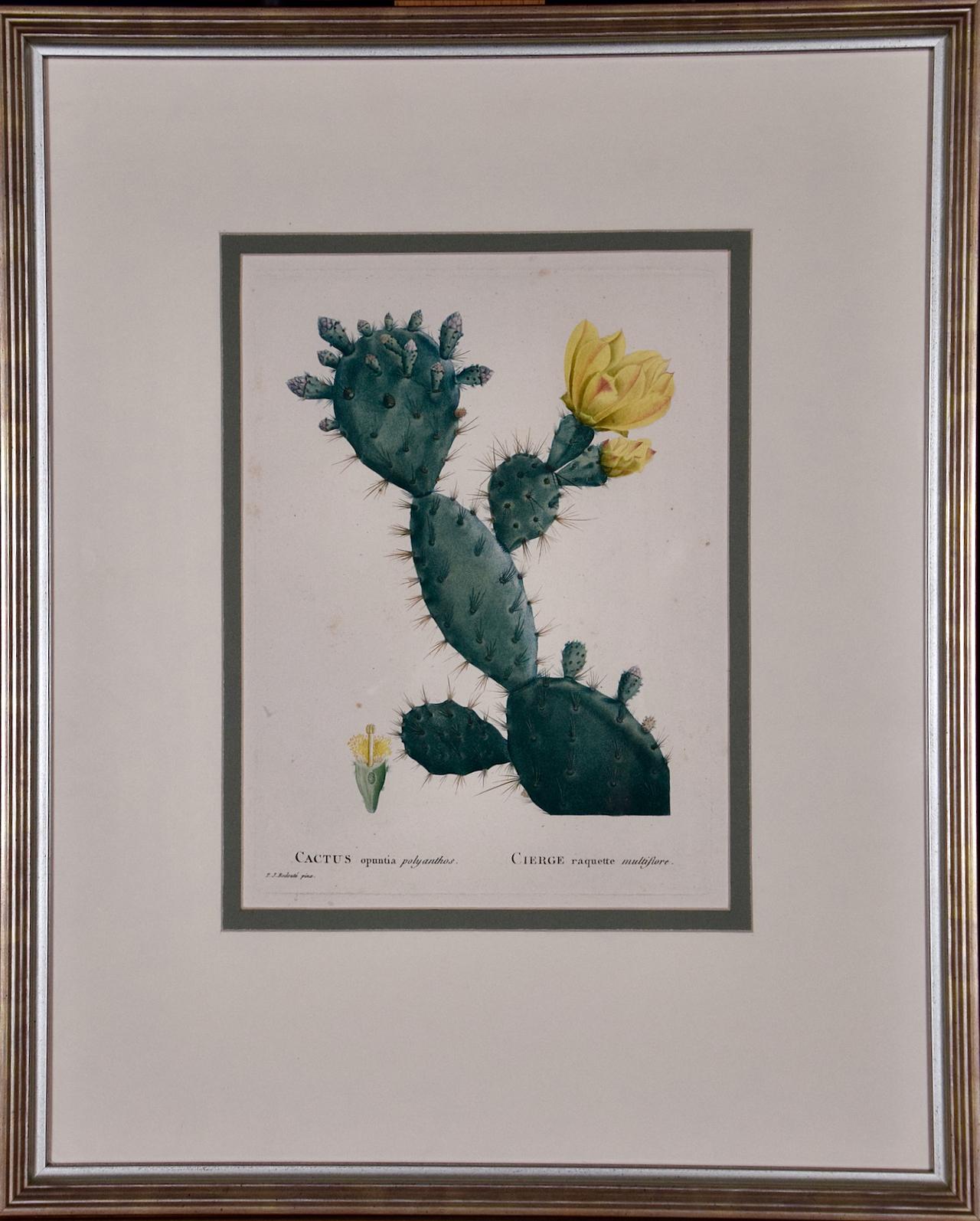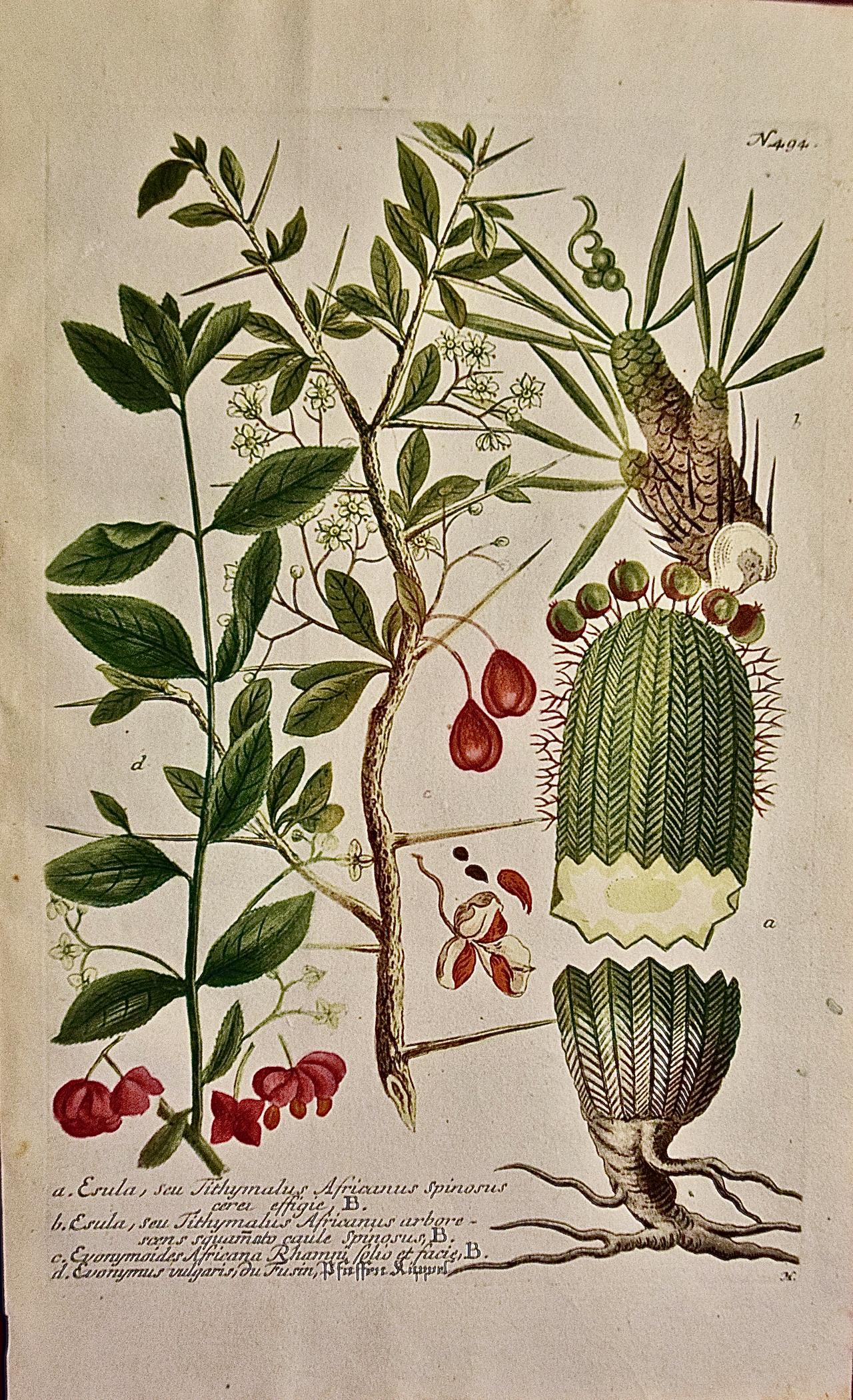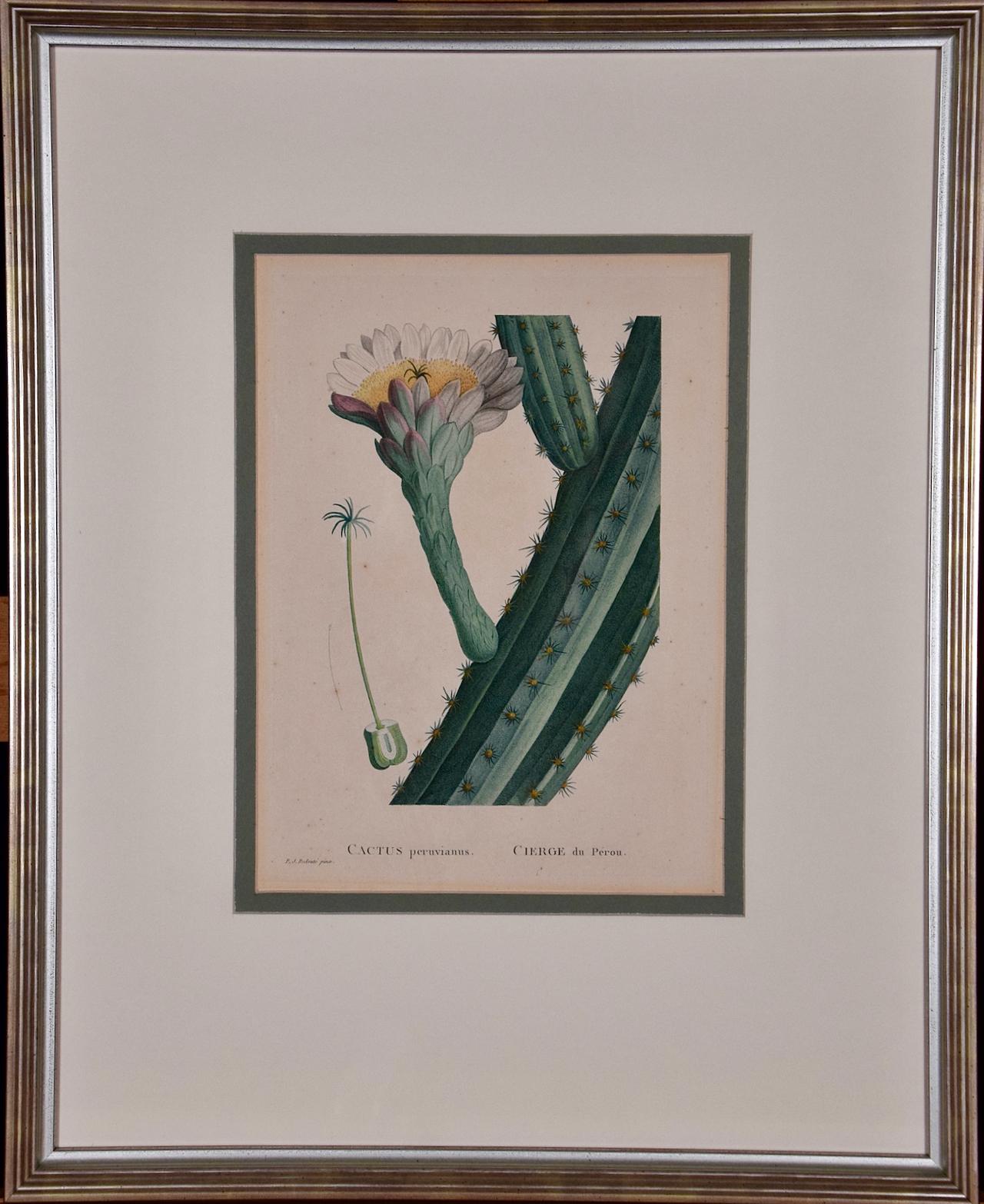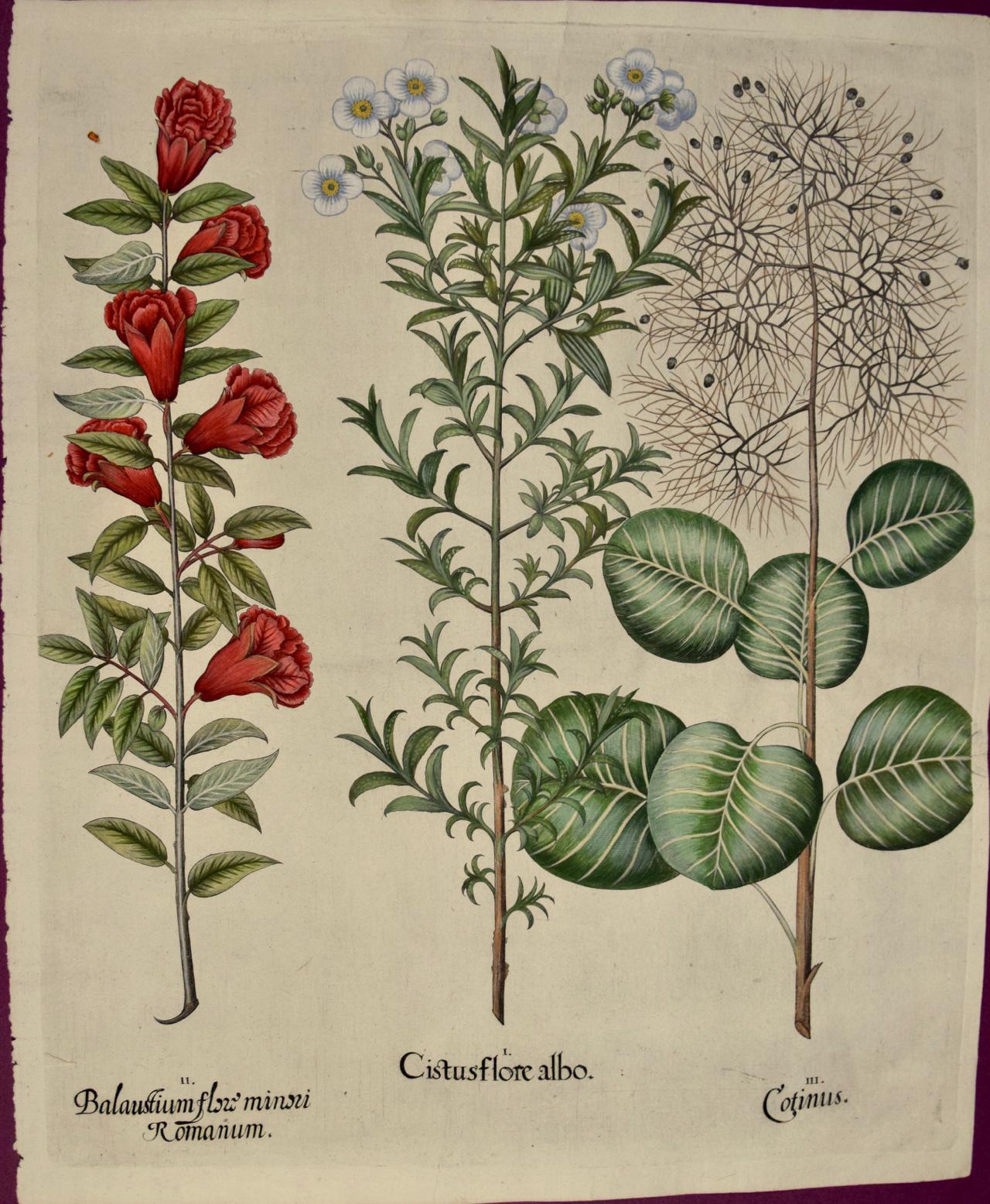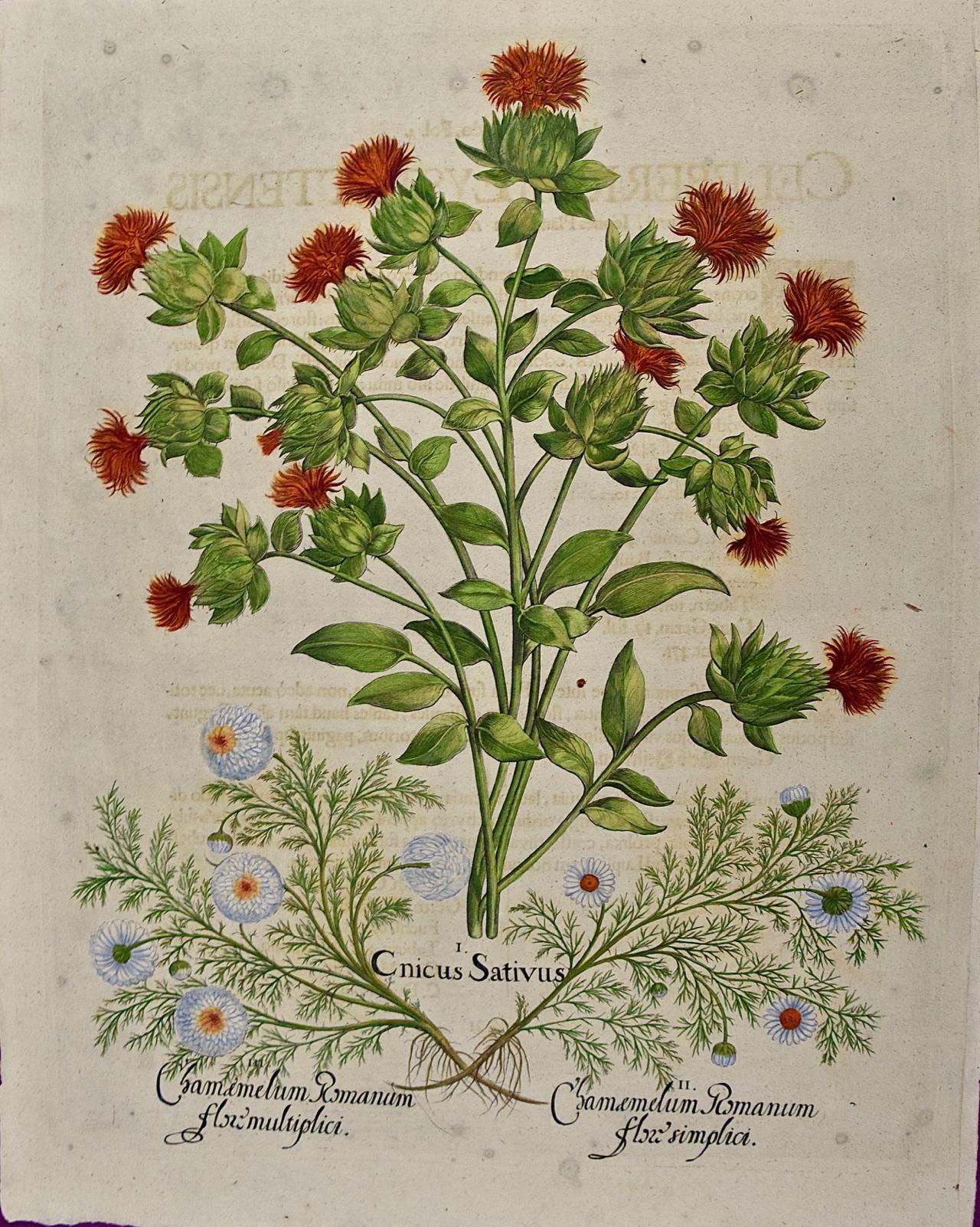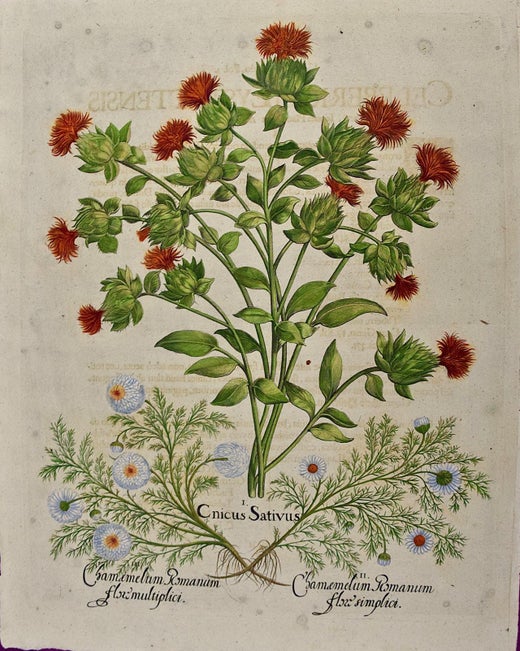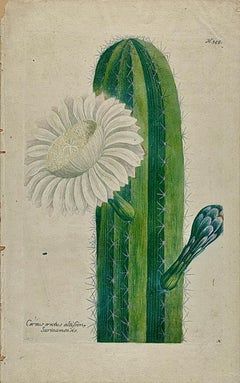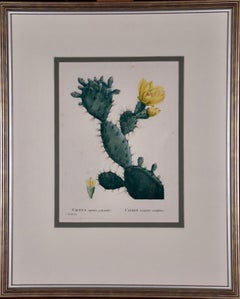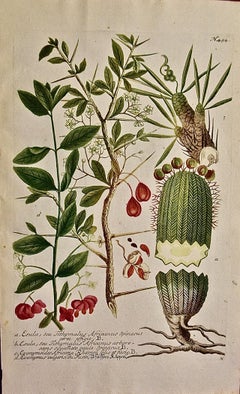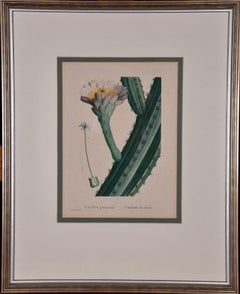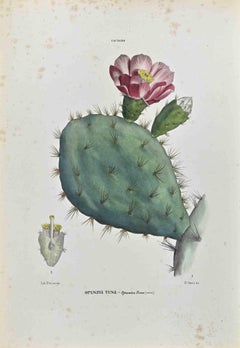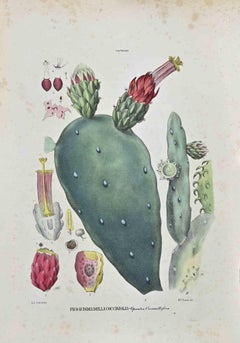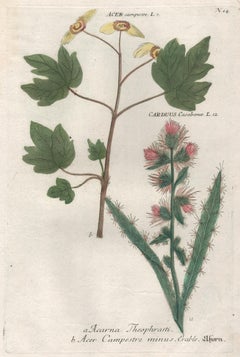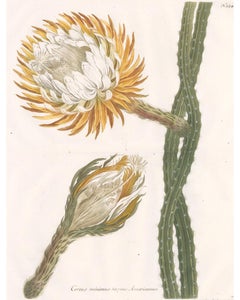Items Similar to Cactus & Rose of Jericho Plants: A Besler Hand-colored Botanical Engraving
Want more images or videos?
Request additional images or videos from the seller
1 of 10
Basilius BeslerCactus & Rose of Jericho Plants: A Besler Hand-colored Botanical Engraving1713
1713
$3,575
£2,739.35
€3,150.90
CA$5,110.95
A$5,551.42
CHF 2,939.01
MX$67,029.96
NOK 36,690.59
SEK 34,758.51
DKK 23,527.48
About the Item
A hand-colored copper plate engraving depicting flowering "Melocactos" (Turk's Cap Cactus or Mother-in-law's Cushion), "Rosa Hiericontea aperta" (Rose of Jericho Unfolded), "Rosa Hiericontea Enclusa" (Rose of Jericho Folded) plants from Basilius Besler's landmark work, Hortus Eystettensis (Garden at Eichstatt), first published in 1613 in Eichstatt, Germany near Nuremberg and later in 1640 and 1713. The Rose of Jericho is also known a Resurrection Plant, Siempre Viva, or Dinosaur Plant.
This beautiful colorful engraving is printed on thick laid chain-linked paper. There is latin title page on the verso. There is pinpoint hole in the periphery on the right and another on the left. The print is otherwise in excellent condition.
Basilius Besler (1561–1629) was an apothecary and botanist. He was curator of the Willibaldsburg Castle garden of Johann Konrad von Gemmingen, prince bishop of Eichstätt, in Bavaria, who supported Besler's academic and artistic creation and whose funds allowed the purchase of exotic plants from all over Europe. Besler spent 16 years producing drawings of 1084 varieties of plants and flowers in different seasons. These were then engraved on copper plates by master artists, resulting in the 367 beautiful and detailed engravings which comprise Besler's monumental florilegium Hortus Eystettensis, the first large-scale botanical publication.
- Creator:Basilius Besler
- Creation Year:1713
- Dimensions:Height: 20 in (50.8 cm)Width: 17.5 in (44.45 cm)
- Medium:
- Movement & Style:
- Period:
- Framing:Framing Options Available
- Condition:
- Gallery Location:Alamo, CA
- Reference Number:Seller: # 45451stDibs: LU117327876792
Basilius Besler (1561–1629) was an apothecary and botanist. He was curator of the Willibaldsburg Castle garden of Johann Konrad von Gemmingen, prince bishop of Eichstätt, in Bavaria, who supported Besler's academic and artistic creation and whose funds allowed the purchase of exotic plants from all over Europe. Besler spent 16 years producing drawings of 1084 varieties of plants and flowers in different seasons. These were then engraved on copper plates by master artists, resulting in the 367 beautiful and detailed engravings which comprise Besler's monumental florilegium Hortus Eystettensis, the first large-scale botanical publication.
About the Seller
5.0
Platinum Seller
Premium sellers with a 4.7+ rating and 24-hour response times
Established in 2011
1stDibs seller since 2019
293 sales on 1stDibs
Typical response time: 1 hour
- ShippingRetrieving quote...Shipping from: Alamo, CA
- Return Policy
Authenticity Guarantee
In the unlikely event there’s an issue with an item’s authenticity, contact us within 1 year for a full refund. DetailsMoney-Back Guarantee
If your item is not as described, is damaged in transit, or does not arrive, contact us within 7 days for a full refund. Details24-Hour Cancellation
You have a 24-hour grace period in which to reconsider your purchase, with no questions asked.Vetted Professional Sellers
Our world-class sellers must adhere to strict standards for service and quality, maintaining the integrity of our listings.Price-Match Guarantee
If you find that a seller listed the same item for a lower price elsewhere, we’ll match it.Trusted Global Delivery
Our best-in-class carrier network provides specialized shipping options worldwide, including custom delivery.More From This Seller
View AllA Flowering Cactus Plant: 18th C. Hand-colored Botanical Engraving by Weinmann
By Johann Wilhelm Weinmann
Located in Alamo, CA
This hand-colored botanical mezzotint and line engraving by Johann Wilhelm Weinmann (1683-1741) is entitled "Cereus Erectus Altissimo Surinamensis (Cereus Cactus Plant)". It is plate...
Category
Mid-18th Century Naturalistic Still-life Prints
Materials
Engraving, Mezzotint
Flowering Prickly Pear Cactus: Framed 18th C. Hand-colored Engraving by Redoute
By Pierre-Joseph Redouté
Located in Alamo, CA
This is a hand-colored stipple engraving entitled "Cactus Opuntia Polyanthos, Cierge Raquette Multiflore" (Prickly Pear Cactus) by Pierre-Joseph Redouté, Plate 59 from his illustrated publication 'Plantarum Historia Succulentarum ou Histoire des Plantes Grasses', published in Paris in 1799. Redoute was a pioneer of the stipple engraving technique, which he used to create this image. It involves utilizing a series of small dots worked into a copper plate rather than the more common lines. These dots can be made smaller or thicker depending on the degree of opacity the artist intends for various areas of the print. When inked and applied to paper, this allows for a greater portion of the paper to be seen, which accentuates the appearance of luminosity of the subject the artist is creating. Different color inks are used in the printing process, a time consuming technique known as "a la poupee". The engraving is then finished with watercolor to further enhance the beauty and realism of the print subject.
This engraving of a flowering cactus is presented in a double mat; white outer mat and heather green inner mat.The mat measures 20" x 16" and the sheet measures 19.5" x 13.38". There are wide margins with a few short tears and chips along the the right and upper edges, which are all covered by the mat. There are small spots predominantly in the margins, but a few are present in the image area, but the print is otherwise in very good condition. There is another Redoute flowering cactus listed on 1stdibs, LU117326854582. The pair would make an attractive display grouping.
Pierre-Joseph Redouté (1759-1840), was a painter and botanist originally from Belgium, who pursued his extremely successful artistic career in France. He is well known for his watercolor paintings of roses, lilies and other flowers and their subsequent folio-sized, color stipple engravings. Some believe him to be the greatest botanical illustrator of all time. Redouté was a favorite of the French royal court at the time and of the post French...
Category
Late 18th Century Naturalistic Still-life Prints
Materials
Engraving
Flowering Spurge: 18th Century Hand-colored Botanical Engraving by J. Weinmann
By Johann Wilhelm Weinmann
Located in Alamo, CA
This hand-colored botanical mezzotint and line engraving by Johann Wilhelm Weinmann (1683-1741) is entitled "A. Esula seu Tithyinalus Africanus SpinosusCera Effigie, B. Esula seu Ti...
Category
Mid-18th Century Naturalistic Still-life Prints
Materials
Engraving, Mezzotint
Flowering Cactus: A Framed 18th C. Hand-colored Engraving by Redoute
By Pierre-Joseph Redouté
Located in Alamo, CA
This framed hand-colored stipple engraving entitled "Cactus Peruvianus Cierge du Pérou" by Pierre-Joseph Redouté, Plate 58 from his illustrated publication 'Plantarum Historia Succulentarum ou Histoire des Plantes Grasses', published in Paris in 1799. It depicts a branching limb of a cactus with a beautiful flower. There is a separate detail of the anatomy of a seed with early growth. Redoute was a pioneer of the stipple engraving technique, which he used to create this image. It involves utilizing a series of small dots worked into a copper plate rather than the more common lines. These dots can be made smaller or thicker depending on the degree of opacity the artist intends for various areas of the print. When inked and applied to paper, this allows for a greater portion of the paper to be seen, which accentuates the appearance of luminosity of the subject the artist is creating. Different color inks are used in the printing process, a time consuming technique known as "a la poupee". The engraving is then finished with watercolor to further enhance the beauty and realism of the print subject.
This engraving of a flowering cactus is presented in silver-colored ribbed wood frame and a double mat; cream-colored outer mat and heather green inner mat. The frame measures 21.25" high by 17.25" wide by 1.13" deep. The sheet measures 19.88" high by 14" wide. There are wide margins with a few short tears and chips along the the left, right and upper edges, which are all covered by the mat. There are small spots predominantly in the margins, with a few present in the image area. The print is otherwise in very good condition. There is another Redoute flowering cactus listed on 1stdibs, LU117326853392, which is framed and matted identically to this one. The pair would make an attractive display grouping.
Pierre-Joseph Redouté (1759-1840), was a painter and botanist originally from Belgium, who pursued his extremely successful artistic career in France. He is well known for his watercolor paintings of roses, lilies and other flowers and their subsequent folio-sized, color stipple engravings. Some believe him to be the greatest botanical illustrator of all time. Redouté was a favorite of the French royal court at the time and of the post French...
Category
Late 18th Century Naturalistic Still-life Prints
Materials
Engraving
Flowering Pomegranate & Rock Rose: A 17th C. Besler Hand-colored Engraving
Located in Alamo, CA
This is a hand-colored copper-plate engraving entitled "Cistusflore Albo, Balaustium Flore Minori Romanum, Cotinus", depicting flowering Pomegranate, Rock Rose...
Category
1640s Academic Still-life Prints
Materials
Engraving
Chamomile & Safflower: A 17th-18th C. Besler Hand-colored Botanical Engraving
Located in Alamo, CA
This is a hand-colored copper plate engraving entitled "Chamemelum Romanum flore simplici (Chamomile), Cincus Sativus (False saffron, Safflower), Chamaemelum Romanum Flore (Roman Chamomile)", depicting flowering Chamomile, Safflower and Roman Chamomile plants respectively from Basilius Besler's landmark work, Hortus Eystettensis (Garden at Eichstatt), first published in 1613 in Eichstatt, Germany near Nuremberg and later in 1640 and 1713.
This beautiful colorful engraving is printed on thin laid chain-linked paper with wide margins. There are a few small spots and some irregularity of the lower edge. There is some bleed-through of text from the verso. The print is otherwise in excellent condition with striking hand-coloring. The sheet measures 22.25" high and 17.38" wide.
Basilius Besler (1561–1629) was an apothecary and botanist. He was curator of the Willibaldsburg Castle garden of Johann Konrad von Gemmingen, prince bishop...
Category
Early 18th Century Academic Still-life Prints
Materials
Engraving
You May Also Like
The Cactaceae - Lithograph by Vincenzo Tenore - 1870s
Located in Roma, IT
Lithograph hand watercolored.
Plate from "Atlante di Botanica popolare ossia Illustrazione di Piante Notevoli di ogni famiglia" (Atlas of popular botany or illustration of notable p...
Category
1870s Modern Figurative Prints
Materials
Lithograph
The Cactaceae - Lithograph by Vincenzo Tenore - 1870s
Located in Roma, IT
Lithograph hand watercolored.
Plate from "Atlante di Botanica popolare ossia Illustrazione di Piante Notevoli di ogni famiglia" (Atlas of popular botany or illustration of notable p...
Category
1870s Modern Figurative Prints
Materials
Lithograph
Acer & Carduus - 18th century Weinmann botanical plant flower engraving
By Johann Wilhelm Weinmann
Located in Melbourne, Victoria
'Acarna Theophrasti' and 'Acer Campestre minus'
Mezzotint printed in colours. Circa 1740.
From Johann W Weinmann's Phytanthoza Iconographia, published in Regensburg 1737-45. The fi...
Category
18th Century Naturalistic Still-life Prints
Materials
Engraving
Flowering Cactus Engraving
By Johann Wilhelm Weinmann
Located in New York, NY
Original engraving by Johann Wilhelm Weinmann from "Phytanthosa Iconographia." Ratisbon, 1737-1745.
This plate: Cereus Minimus Serpens Americanus. [Cactus].
Mezzotint engraving print...
Category
Early 18th Century Prints and Multiples
Materials
Laid Paper
Pair of Original Antique Botanical Prints- Cactus. Dated 1826
Located in St Annes, Lancashire
Wonderful pair of cactus prints.
Lithographs
Original hand color
Published by S.Curtis. Dated 1826
Unframed.
Category
Antique 1820s English Georgian Prints
Materials
Paper
The Cactaceae - Lithograph by Vincenzo Tenore - 1870s
Located in Roma, IT
Lithograph hand watercolored.
Plate from "Atlante di Botanica popolare ossia Illustrazione di Piante Notevoli di ogni famiglia" (Atlas of popular botany or illustration of notable p...
Category
1870s Modern Figurative Prints
Materials
Lithograph
More Ways To Browse
Antique Engraving Plates
Copper Engraving Plate
Hand Colored Botanical
18th Century Botanicals
Hand Colored Copper Engraving
Hand Colored Botanical Prints
18th Century Botanical Prints
Dinosaur Antique
Abstract Reclining Sculpture
Agustin Cardenas
Anne De Villemejane
Astronaut Sculpture
Bamboo Pen
Bill Hemmerling
Blue Dog Original
Boy Horse
Brandon V Lewis
Bronze Of Ballet Dancers
